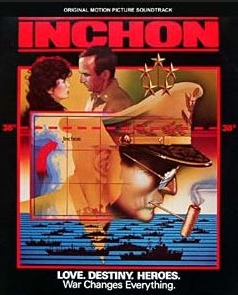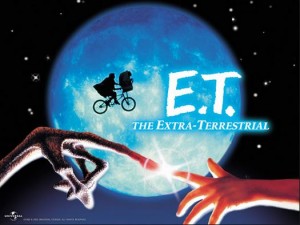
Movie projection platter system with two films ready to show. The individual reels have been spliced end-to-end. The film feeds through the projector via a complex systems of pulleys, springs and electric motors
If anything qualifies as a contraption, it’s got to be the system of platters, pulleys and electric motors now used in movie theaters, instead of reels, to feed film to and from the projectors. Setting up platters is tricky and takes practice, as I learned when I managed the Cross Keys Cinema.
Once in a while we got a first run movie at Cross Keys instead of the usual grade-B and end-of-the-run leftovers that comprised the bottom end of the Wehrenberg chain’s booking package.
Weeks of pre-release publicity and a contest preceded the arrival on our screen, on Friday September 17, 1982, of Inchon, a Korean War epic about General Douglas MacArthur’s amphibious invasion north of Seoul. God, according to the Reverend Sun Myung Moon, inspired his Unification Church to finance the film that took five years and $46 million to produce. Contest enthusiasts called the theater asking for blocks of entry forms and one even stopped by to regale me at length with his plans for spending his winnings.
In the end, Inchon bombed at the box office and earned the Golden Raspberry Worst Picture of 1982 award and, for Laurence Olivier who played MacArthur, the only Golden Raspberry Worst Actor award of his career. I have no idea who, if anyone, won the contest intended to promote this film.
On Inchon’s opening night, a with ET in the other auditorium, we had almost eight hundred people in the theater, a first for me as manager. Jerry, the projectionist, was taking the night off to go out with his wife, and the union had supplied a substitute, a short, stocky man with sandy hair. This new projectionist was not one of the regular guys I recognized, but a man from a rural area outside St. Louis.
Twenty minutes after the films started both screens went dark. I buzzed the booth on the intercom. “It’ll be just a minute or two,” the substitute said and I reassured the customers who were now streaming out of both theaters to complain.
The screens stayed dark and continued to stay dark. I sprinted upstairs to the booth, and found several hundred feet of film on the floor. The new man had no idea what to do, and neither did I. I ran back to the office and called Jerry at home, catching him in the shower. I pleaded and he agreed to come in. I assured the customers that the regular man was on the way.
A slender guy in a green sweater and slacks from the Inchon audience confronted me beside the concession stand.
What’s so hard about running a movie projector? I show home movies all the time. Your projectionist must be stupid. Let me go up there and I’ll fix it if he can’t!
The projectors are fed by a complex platter system, not ordinary reels,” I told him, “and I can’t let you into the booth.
He did not seem to like my answer and turned away. Just then, out of the corner of my eye, I saw Jerry come in the front door and head upstairs to the booth. “Dave,” he told me after one look at the film on the floor, “it would take me a couple of hours to untangle all of this. Maybe you’d better start refunding.”
I reached my district manager, Paul at another theater to get authorization to refund 800 movie tickets in cash. “I’ll be right there,” he said. I was busy refunding when Paul arrived to take over dealing with the angry customers who by then had decided that the entire debacle was my fault. “This manager,” Paul told them, “does not hire the projectionists. We have to take whoever the union sends, but the contract requires that substitutes know the equipment.”
The man who was such an expert at showing home movies confronted Paul.
Why did you hire this idiot?” he demanded, pointing at me. “I run the main St Louis office of the Missouri Division of Employment Security on Washington Avenue and we wouldn’t recommend him for anything.
I reacted without thinking:
I’m not taking any more shit from you!
Dave, why don’t you wait in the office for a minute, Paul suggested quietly.
Paul continued to talk with the guy from the employment office while I worked with the refunds. Eventually the lobby emptied and the angry man left.
“I’m calling my lawyer, and we’re going to sue you,” were his parting words.
Jerry, a muscular bearded man who stood over six feet tall, had been watching the whole episode with the irate customer from a position at the side of the lobby, and told me, “Dave, if he had laid a hand on you, I would have taken him out.”
I didn’t sleep at all that night, wracked with worry that I’d be fired. I talked with Paul in the morning and he assured that everything would be OK. The catastrophe of the previous evening wasn’t my fault and the upper management understood.
A few days later, when the fill-in projectionist came by to get paid for his one evening’s work, he carried a baby with him, perhaps, I thought, to shield him from a violent confrontation with Jerry, whose night off with his wife had been ruined, or possibly with me. He needn’t have worried; Jerry wasn’t at the theater and I was only relieved to have kept my job.
Just for fun, I estimated the amount of film that could have lain tangled on the floor of the projection booth at Cross Keys that disastrous night in 1982. Inchon, the box-office catastrophe, ran 105 minutes consuming 9,450 feet of regular 35-mm movie film. E.T. The Extraterrestrial, the Spielberg blockbuster, ran 115 minutes and required 10,350 feet of film. Add another 1000 feet for trailers and previews, and you get a total of 20,800 feet; that’s almost four miles of film for both features. If just half of it lay sprawled and tangled all over the floor of our booth that would be two miles, which even the most experienced projectionist couldn’t sort out in under an hour.
By the way, the angry man from the employment office never sued, and within a year I found better work without his help.
Next time – Strike



